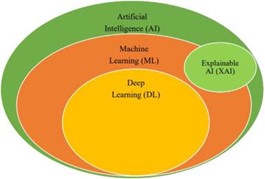
Modern cybersecurity has reached an exceptional level, particularly with the integration of AI technology. The complexity of cyberattacks and their methodologies has also increased significantly, even surpassing human comprehension. This poses a considerable challenge for cybersecurity professionals who struggle to keep pace with the scale and complexity of AI-generated attacks.
The widespread use of ML models often overlooks the importance of ensuring accuracy, reliability, and fairness in decision-making. As AI-generated attacks continue to rise, security professionals must prioritize investigating the inner workings of AI models. This deeper understanding is essential for achieving clarity before their adoption or deployment. This is achieved by Explainable AI (XAI).
In early 2017, the Defense Advanced Research Projects Agency (DARPA) introduced Explainable AI to improve transparency in AI systems. XAI encompasses techniques, design principles, and processes that enable developers and organizations to add transparency to AI algorithms, XAI can describe AI models, their expected impact, and potential biases thereby rendering artificial intelligence processes and decisions more accessible to humans.

XAI principles
The US National Institute of Standards and Technology (NIST) introduced four principles of Explainable AI. These four principles guide the consideration of whether the explanation meets user needs. This is currently a field of active research.
1) Explanation
The Explanation principle mandates that an AI system offers evidence or reasoning for its outcomes or processes, without specifying their quality, assessed by other principles such as meaningfulness and accuracy. Given diverse systems and scenarios, explanations vary widely in execution. Thus, a broad definition is adopted to suit various applications.
2) Meaningful
The Meaningful principle is met when recipients understand the system's explanations. Factors such as stating why the system behaved a certain way contribute to this understanding. Developers must consider audience knowledge and psychological differences. Meeting the Meaningful principle involves understanding the audience's needs, expertise level, and relevance to the question.
3) Explanation Accuracy
Explanation Accuracy ensures explanations accurately reflect the system's process or output reasons, distinct from Decision Accuracy. While Decision Accuracy measures correctness, Explanation Accuracy focuses on truthfulness. This principle allows flexibility in determining explanation accuracy to suit diverse audience needs and contexts.
4) Knowledge Limits
Knowledge Limits ensure a system operates within its designed conditions and reaches sufficient confidence in its output. This principle identifies cases where the system operates beyond its scope or when answers are unreliable. By declaring knowledge limits, the system safeguards against inappropriate judgments, enhancing trust by preventing misleading or dangerous outputs.
XAI model interpretability
XAI model interpretability refers to the clarity with which decisions made by an AI model can be understood and explained. It measures how well a human can grasp the reasoning behind a decision. The higher the interpretability of an ML model, the more easily its predictions can be comprehended. In the book "Interpretable Machine Learning,” the following XAI taxonomy is suggested:
By model: Intrinsic or Post hoc
Interpretability can be intrinsic or extrinsic (post-hoc), indicating whether the model is understandable on its own or requires post-training methods for interpretability. Simple models like decision trees are intrinsic, while post-training methods are extrinsic. Using simpler models may suffice if complexity isn't needed, but complex models pose challenges for human comprehension, often requiring post-training interpretations.
By method: Model-agnostic or Model-specific
Model-specific methods are tailored to a particular model, while model-agnostic methods can be applied to any ML model. Model-agnostic methods lack access to internal model data, such as weights and structural details, making them versatile across different models.
By scope: Global or Local
Local methods explain a single prediction, while global methods interpret the entire model's behavior.
Interpretability is crucial for grasping the cause and effect within an AI system, while explainability goes further by clarifying how and why a model makes predictions in a human-readable format. In cybersecurity, where AI often operates as a black box, achieving both interpretability and explainability becomes essential.
Use cases of XAI in cybersecurity
- Threat Detection: XAI enables cybersecurity analysts to grasp why specific activities or anomalies are flagged as potential threats, shedding light on the decision-making process of detection systems.
- Incident Response: XAI assists cybersecurity investigators in uncovering the root causes of security incidents and identifying potential indicators of compromise more efficiently.
- Vulnerability and Risk Assessment: XAI techniques offer transparency into vulnerability and risk assessments, helping organizations understand why certain vulnerabilities are prioritized and enabling clearer prioritization of security measures and resource allocation.
- Compliance and Regulation: XAI assists organizations in meeting GDPR or HIPAA regulations by offering clear explanations for AI-driven data protection and privacy decisions. GDPR and HIPAA require transparency, rendering black box AI a legal liability, especially for organizations subject to these regulations.
- Security Automation: XAI enhances the transparency of automated security processes, such as firewall rule generation or access control decisions, by explaining the actions taken by AI systems.
- Model Verification and Validation: XAI supports verifying the accuracy and fairness of AI models utilized in cybersecurity applications, ensuring they operate as intended and do not exhibit biases or unintended behaviors.
Adversarial XAI methods in cybersecurity
Adversarial XAI methods are techniques used to analyze and exploit vulnerabilities in explainable artificial intelligence (XAI) systems.
Explanation manipulation attacks occur when individuals with malicious intent use techniques after the fact to hide vulnerabilities in their models and argue that their black box models are fair. Recent research has also demonstrated that explanations provided by AI systems can be influenced by small changes in input data, even if these changes don't affect the final classification outcome.
Moreover, adversaries exploit exposed explanations to compromise system security, leading to privacy breaches and evasion attacks. Privacy degradation attacks involve extracting sensitive information from models or inferring membership or attributes. Evasion attacks include the generation of adversarial examples, data/model poisoning, and backdoor injection techniques.
Conclusion
The widespread adoption of AI underscores the critical need for explainable AI (XAI) in cybersecurity. XAI enhances transparency and understanding of AI-driven decisions, vital for ensuring security and trust in AI systems. However, even XAI is not immune to threats. Manipulation of explanations and evasion attacks pose significant risks to system security and privacy. Moving forward, it is crucial to prioritize research and development efforts to proactively address these threats.
Editor’s Note: The opinions expressed in this guest author article are solely those of the contributor and do not necessarily reflect those of Tripwire.
